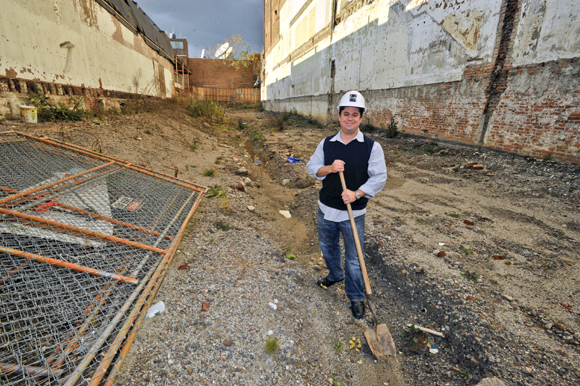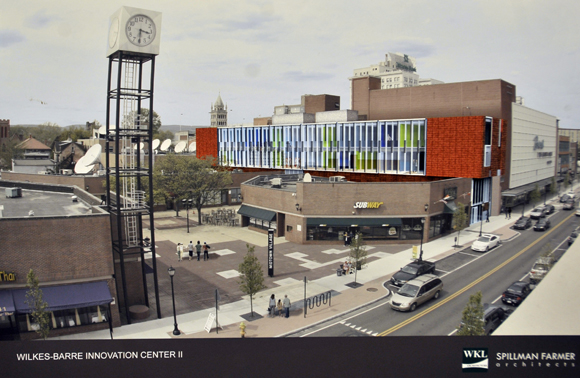At the former Woolworth building on Main Street in Wilkes-Barre, the street-level Barnes & Noble college bookstore is immediately obvious. Less obvious, however, is a plaque that marks the Innovation Center @ Wilkes-Barre, a small-business incubator run by the Chamber of Business and Industry. Almost eight years old, the ICWB is full and still garnering interest, so it will open a new space two doors down in spring 2012.
According to John Augustine, the Chamber's Senior Director of Economic and Entrepreneurial Development, the new three-floor building will add about 20,000 square feet, a 33-percent expansion of the incubator. Like the current building, the new one will mix retail space, Class A office space, and the incubator and accelerator for small businesses. The retail space helps generate income.
The incubator space is rented below market value to new start-ups, which might spend three to five years in the incubator. These companies gain access to the shared resources of the ICWB, which include not just other entrepreneurs to share ideas but also the basic infrastructure of any office–breakrooms, bathrooms, Internet, photocopiers, and so on–and the assistance of the ICWB's advisors, human resources, and attorneys. As companies grow and solidify their operations, they can move out of the building or move into the accelerator space, where they pay market-rate rents.
The Ultimate Success
In the current accelerator space, PepperJam Exchange illustrates the value of the ICWB. The company is an online marketing agency with a wide variety of support for e-commerce and interactive marketing. One of the first tenants in the ICWB, PepperJam was bought by GSI Commerce in 2009, which was in turn acquired by e-Bay earlier this year.
Co-founder and current PepperJam General Manager Michael Jones says the Innovation Center was instrumental in helping his company get its feet on the ground and to “look professional” as it offered a variety of shared services and shared space the young startup could not otherwise afford.
“Many of the companies in the Innovation Center were also tech startups so there was a lot of idea sharing that was beneficial because many of us in the Innovation Center were experiencing the same types of issues,” Jones says. “We started with 2 people and grew to over 70 employees and we couldn’t have had a better home for our growth than the IC.”
Augustine relishes the success of PepperJam.
“We have e-Bay in downtown Wilkes-Barre; not a lot of people know that,” he says.
Augustine also relishes the fact that PepperJam has spun off additional local companies and helps retain young tech workers in the city. Augustine says the average annual salary paid by a company in the ICWB is $60,000. “These professionals,” adds Jones, “rent apartments and buy homes in NEPA, they eat lunches and dinners in the area each day and have in many cases become active members of the business and social culture of the area.” All told, Augustine calculates the ICWB contributes about $1.5 million annually to the region.
Impact Beyond the Incubator
Another tenant that benefits from the ICWB and in turn benefits the community is Data Makes the Difference, which makes cell phone and iPad apps such as the Behavior Tracker Pro to help children with autism. The children's parents, teachers, and others can quickly enter data and look for patterns in order to improve behavioral analysis treatment.
Steve Maher combined his expertise in computers with his wife's expertise in special education and recruited some help to launch the company not quite two years ago.
“The innovation center has helped Data Makes the Difference with low cost office space as well as access to advisors who in turned helped us get funding via a grant for the Technology Collaborative,” Maher says.
“Because of the grant, we have been able to triple the number of apps we have, significantly enhance the apps in ways that have now doubled sales, and also funded the creation of a web-based service we call the Team Portal that allows our users to store behavior data in a secure collaborative environment.”
Analyzing such successes, Augustine plans to replicate them in the new space and apply some lessons learned from the first building. First, the Chamber will be “implementing a virtual incubator for the next year. Someone may not need space, but we can take the experience we’ve had and carry over to all entrepreneurs. All the tools someone might need to be successful, we want to provide in one package.”
Second, he foresees a slew of physical and social improvements: more mentoring, a bigger break room with TVs and video games, easier circulation through the building, a more welcoming foyer, better signage, and potentially taking a stake in companies instead of collecting rent. The Chamber is also building to LEED standards.
Finally, the new ICWB site takes advantage of grants to be built without any debt financing, unlike the first site, which cost $6 million. The new incubator space will cost about $5 million to construct. Of that, $2.2 million came from the federal Economic Development Administration. Another $1 million came from the Local Share Account, which disburses Luzerne County's gambling revenue. The state contributed the rest as $1 million from the Infrastructure Development Program and $475,000 from Growing Greener II for urban revitalization.
MARK MEIER is a writer, independent consultant, and part-time professor who lives in Dunmore and plants butterfly gardens in Scranton (which is his back yard). Send feedback here.
PHOTOS:
John Augustine of the Wilkes Barre Chamber of Commerce at the site where the new incubator will be built.
The site of the new incubator is just one building away from the existing, wildly successful Innovation Center.
Augustine points out the full glass windows each business will have.
Rendering of the Wilkes Barre Innovation Center II.
The floor plan for the Wilkes-Barre Innovation Center II.
All photographs by AIMEE DILGER





